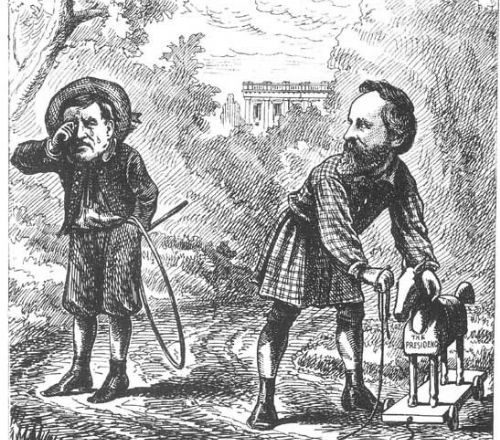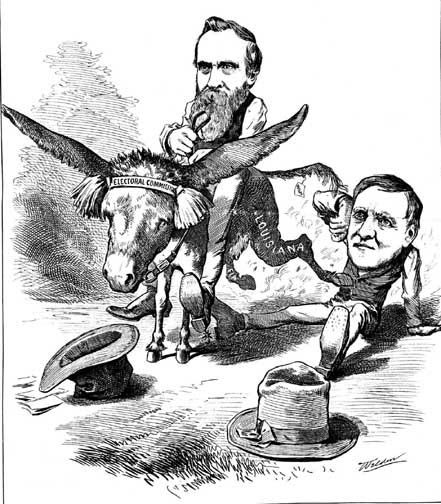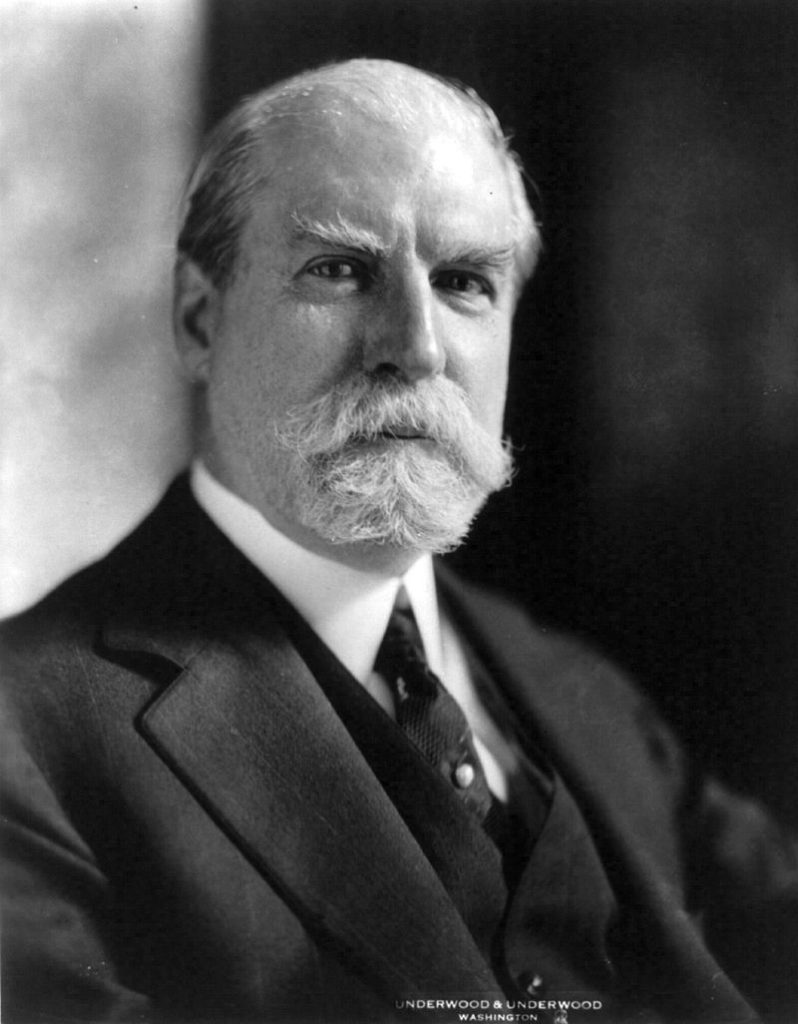Door County Historically Votes Republican in Presidential Elections
- Share
- Tweet
- Pin
- Share

In the 42 presidential elections since Wisconsin became a state in May 1848, residents have voted for Democratic candidates 17 times and Republicans 24 times. In one presidential year – 1924 – state residents overwhelmingly supported third party candidate and native son Robert LaFollette and his Progressive Party, rather than the eventual Republican winner, Calvin Coolidge.
Door County vote totals began appearing in the Seventh Annual Wisconsin Legislative Manual in 1868 (now known as the State of Wisconsin Blue Book). In all that time, Door County has only voted six times for the Democratic presidential candidate – FDR in 1932 and ’36, LBJ in 1964, Bill Clinton in 1996, and Barack Obama in 2008 and ’12. And it followed the rest of the state in 1924 by giving the majority of its votes to Progressive Party candidate LaFollette.
1848
Wisconsin voted for Democrat Lewis Cass (15,001 votes), former governor of the Michigan territory (1813-1831), who lost to Zachary Taylor (13,747 votes), a Whig. Taylor had 47.3 percent of the national vote, Cass had 42.5 percent and Martin Van Buren, a Free Soil candidate, took 10.1 percent. Van Buren came a close third in Wisconsin with 10,418 votes.
1852
Wisconsin voted for Democratic candidate Franklin Pierce (33,658 or 52 percent), who won with 50.8 percent of the national vote. His opponent, Winfield Scott, took 22,240 votes in Wisconsin. Third-party candidate John P. Hale scored 8,814 votes.
1856
Wisconsin voted for losing Republican candidate John C. Fremont (66,090 votes), who took 33.1 percent of the national vote. Democrat James Buchanan (54,843 Wisconsin votes) won with 45.3 percent of the vote. Millard Fillmore (579 Wisconsin votes), running as a Know Nothing candidate, took 21.5 percent.
1860-64
Wisconsin supported Republican candidate Abraham Lincoln (86,119 Wisconsin votes in 1860 and 83,458 in ’64), who defeated four contenders in 1860 with 39.8 percent of the national vote. His chief opponent, Democrat Stephen A. Douglas, took 64,021 votes in the state (Douglas had a connection to the state – the most northwestern county in the state is named for him – Douglas County – and he started the first newspaper, The Chronicle, in the City of Superior). In 1864 against Democrat George B. McClellan (65,884 state votes), Lincoln took 55 percent of the national vote.
1868-72
 Wisconsin voted for Republican winner Ulysses S. Grant, who took 52.7 percent of the national vote in the first election and 55.6 percent in the second. Door County voters cast 873 votes for Grant in 1868 and 596 for his Democratic contender, Samuel Tilden.
Wisconsin voted for Republican winner Ulysses S. Grant, who took 52.7 percent of the national vote in the first election and 55.6 percent in the second. Door County voters cast 873 votes for Grant in 1868 and 596 for his Democratic contender, Samuel Tilden.
1876

Political cartoon showing Republican Rutherford Hayes prevailing in the hotly disputed 1876 presidential election with Democrat Samuel Tilden, from the N.Y. Daily Graphic, Feb. 26, 1877.
Wisconsin went for Republican Rutherford B. Hayes, who lost the popular vote (47.9 percent to Democrat Samuel Tilden’s 50.9 percent), but carried 21 states to Tilden’s 17, and thus earned one more electoral vote to put him over; 185 electoral votes were need to win. The election was reputedly wrought with fraud and the post-election controversy full of spin on all sides. It is often referred to as “The Stolen Election.” Both Wisconsin and Door County went with Hayes. In the state, Hayes took 130,067 to Tilden’s 123,926. Door County’s total was 1,095 for Hayes and 596 for Tilden, although Tilden won in several towns – Baileys Harbor, 61-43; Egg Harbor, 62-38; Nasewaupee, 56-40; and Sevastopol, 55-35.
On Nov. 9, 1876, the Door County Advocate reported: “Conflicting reports reach us as we go to press, as to the result of the electoral ticket. The Chairman of the Democratic State Committee telegraphs from LaCrosse that Tilden has 184 electoral votes, and that Wisconsin will decide the contest. If that is reliable, then, as Wisconsin has gone Republican by over 3,000, that would give the victory to HAYES and WHEELER. Another report reaches us that Louisiana is in doubt, both parties claiming it, and that the Democrats having 184 electoral votes, it remains for Louisiana to decide the contest. The result is so close that it will take another 24 hours to decide which wins.”
And the Nov. 10, 1876, Expositor, said: “The election, as far as we have learned, passed off peaceably through the United States. There was, however, a vast amount of corruption indulged in by both parties, of which is as usual, the party in power used the lion’s share. The republicans were fighting for a continuance of their corrupt rule, whole the reformers were fighting for reform.”
In its next issue one week later, the Advocate wrote: “It is not yet known whether HAYES or TILDEN is to be our next president. The result depends upon the official count in Louisiana, Florida and South Carolina, and it will be some days before the votes of those States will be canvassed.”
That same issue carried a column about the Electoral College that began: “The Electoral College is a relic of the past.”
And still no resolve when the next issue came out on Nov. 23, reporting that the Louisiana vote was still under question: “The result of the canvass will be determined by the party who can prove the greatest number of frauds on the other fellows.”
In the Dec. 1, 1876, Expositor: “As soon as it became known that Tilden had 184 votes beyond dispute, one less than the number required to elect, and that he could be defeated by securing South Carolina, Florida and Louisiana against him, his defeat by fraud was determined upon.” The article went on to accuse those southern states of being “under republican carpet-bag rule” and claims Tilden had a clear majority in all three of those states, but republicans were finding ways to throw out enough Tilden votes to give Hayes the presidency. The presidential recount in South Carolina just added to the massive political woes that state was suffering. The race for governor was so contentious that President Grant sent Gen. William Tecumseh Sherman and federal troops to the state in October to ensure peaceful voting in November. The troops remained until April 1877.
Finally, in the Dec. 7 edition, the Advocate proclaimed that Republicans had won by small majorities in the contested states.
1880
Wisconsin helped elect Republican James A. Garfield (141,398) in a very close popular vote with Democrat Winfield Scott Hancock (114,644). Garfield received 48.27 percent of the national votes to Hancock’s 48.25 percent. In Door County, Garfield won 1,357 to Hancock’s 635.
1884

Both Wisconsin and Door County voted for Republican James G. Blaine in the 1884 election, but in another close popular vote, the presidency went to Democrat Grover Cleveland. Blaine went on to serve twice as United States Secretary of State under three different Republican presidents (Harrison, Garfield and Arthur).
In another close popular vote, Wisconsin voted for Republican James G. Blaine (161,157) (48.3 percent), who lost to Democrat Grover Cleveland (146,477). Cleveland won 48.9 percent of the national vote to Blaine’s 48.3 percent. In Door County the vote was 1,838 for Blaine and 1,117 for Cleveland.
1888
Wisconsin went for Republican winner Benjamin Harrison (176,553), who lost the popular vote to incumbent Grover Cleveland (155,232) – 47.8 percent to 48.6 percent – but won the electoral vote, 223 to 168. Door County also sided with the Republican challenger, 1,688 to 1,018.
1892
Wisconsin went Democrat, helping to return Grover Cleveland to the White House. The vote in Wisconsin was 177,325 for Cleveland, who took 46 percent of the national vote. Incumbent Harrison took 171,101 Wisconsin votes and 43 percent nationally. Door County remained Republican, giving Harrison 1,596 votes to Cleveland’s 1,007.
1896-1900
Wisconsin supported Republican William McKinley rather than Democrat William Jennings Bryan during both presidential years. In ’96 McKinley earned 268,135 votes to Bryan’s 165,523, and a similar landslide was recorded in Door County with 2,402 for McKinley to 895 for Bryan. The results were similar in the 1900 election, with McKinley taking 265,760 and Bryan 159,163 in the state, and 2,362 for McKinley and 674 for Bryan in Door County. McKinley took 51.03 percent of the national vote in ’96 and 51.6 percent in 1900.
1904
Wisconsin joined the landslide vote for incumbent Republican Theodore Roosevelt, who at the age of 42 had become the youngest president in history when he moved from vice president to the highest office upon the assassination of McKinley in Sept. 1901. Roosevelt took 280,161 votes to Democratic challenger Alton Parker’s 121,107. In Door County, Teddy won 2,689 to 515.
Roosevelt took 56.4 percent of the national vote.
1908
Wisconsin supported Republican William Howard Taft (247,747) rather than perennial Democratic candidate William Jennings Bryan (166,632). Door County followed suit, with 2,463 for Taft and 778 for Bryan. Taft took 51.6 percent of the national vote.
1912
Wisconsin went with Democratic candidate Woodrow Wilson in the four-way race. Wilson took 41.8 percent of the national vote, compared to Progressive candidate Theodore Roosevelt with 27.4 percent, Republican William Howard Taft’s 23.2 percent and Socialist Eugene V. Debs’ 6 percent. Door County, however, went with Taft, giving the Republican 1,267 to Wilson’s 769, and Roosevelt in close third with 690, and Debs trailing with 72 votes.
1916

After helping to elect Democrat Woodrow Wilson in 1912, Wisconsin abandoned him in 1916, voting instead for former New York Governor Charles Evans Hughes, who would go on serve as Warren Harding’s Secretary of State in the early 1920s and became the 11th Chief Justice of the United States in 1930 under Herbert Hoover.
Wisconsin and Door County voted for losing Republican candidate Charles E. Hughes. Woodrow Wilson won re-election with 49.2 percent of the national vote. The Door County vote was 1,656 for Hughes to 1,204 for Wilson.
1920
Wisconsin went for Republican Warren G. Harding, who took 60.3 percent of the national vote. Running against him were Democrats James M. Cox and his vice presidential running mate Franklin D. Roosevelt. Door County also voted for Harding, with 3,817 to 895 for Cox and FDR.
1924

While Progressive candidate Robert LaFollette Sr. killed it in his home state of Wisconsin, Republican Calvin Coolidge rolled over him and the Democratic candidate in the national vote.
Wisconsin voted for native son Robert LaFollette Sr., who was running as a Progressive candidate. The state vote was 453,678 for LaFollette, 311,614 for Republican Calvin Coolidge and 68,115 for Democrat John Davis. Nationally, LaFollette took 16.6 percent of the vote to Coolidge’s 54 percent and Davis’ 28.8 percent. In Door County, LaFollette won with 2,715 to Coolidge’s 1,891 and Davis’ 235 votes.
1928
Wisconsin went for Republican winner Herbert Hoover, who took 58.2 percent of the vote. In Door County, Hoover won with 3,636 to Democrat’s 2,456.
1932-40
Wisconsin went for Democratic candidate Franklin D. Roosevelt in all three presidential election cycles during this period. In 32, Roosevelt took 57.4 percent of the national vote, easily defeating incumbent Herbert Hoover. FDR decisively took Wisconsin 707,410 to 347,741. In ’36 Roosevelt took 60.8 percent of the national vote compared to Republican Alf Landon’s 36.5 percent (802,964 to 380,828 in Wisconsin), and in 1940 Roosevelt had 54.7 percent to Republican Wendell Wilkie’s 44.8 percent (704,821 to 679,206 in Wisconsin). In Door County, Roosevelt won in ’32, 4,149 to Hoover’s 2,488; and again in ’36, 3,952 to Landon’s 3,146. But in ’36, Door County switched allegiance, giving Republican contender Wendell Wilkie a landslide win, 5,461 to 2,750 for the incumbent President Roosevelt.
1944
Republican Thomas Dewey won narrowly in Wisconsin when Roosevelt was seeking his fourth term, 674,532 to 656,413. Roosevelt took 53.4 percent of the national vote. Door County also went for Dewey, 5,688 to Roosevelt’s 2,599.
1948
Wisconsin supported Democrat Harry S. Truman, who won 49.6 percent of the national vote compared to Republican Thomas Dewey’s 45.1 percent and Dixiecrat Strom Thurmond’s 2.4 percent. Truman took 647,310 to Dewey’s 590,959 in Wisconsin. Door County stuck with Dewey, 4,911 to 2,440 for Truman.
1952-56
The Republican ticket of Dwight D. Eisenhower and Richard M. Nixon won in Wisconsin, as in the rest of the U.S. in both cycles, with Eisenhower taking 55.2 and 57.4 percent of the U.S. popular vote, respectively, to Democrat Adlai Stevenson’s 44.3 and 42 percent. In Wisconsin, Ike took 979,744 to Stevenson’s 622,175 in ’52 and 954,854 to 586,768 in ’56. It was an Eisenhower landslide in Door County, 7,621 to 1,790 the first time.
1960
Wisconsin stuck with Nixon (895,175 to 830,805) in his first presidential run, but Democrat John F. Kennedy squeaked by with 49.72 percent of the national vote to Nixon’s 49.55 percent. Kennedy outscored Nixon in electoral votes, 303 to 219 (269 were needed). Door County also went with Nixon, giving him 5,790 to Kennedy’s 3,610.
1964
 Wisconsin was one of the overwhelmingly red states that elected Democrat Lyndon Baines Johnson in a popular and electoral landslide win against Republican Barry Goldwater (1,050,424 to 638,495). LBJ received 61.1 percent of the national vote (compared to 62.09 percent in Wisconsin) and racked up 486 electoral votes to Goldwater’s 38.5 percent of the vote and 52 electoral votes. It was much closer in Door County, with Johnson getting 4,416 votes to Goldwater’s 4,289.
Wisconsin was one of the overwhelmingly red states that elected Democrat Lyndon Baines Johnson in a popular and electoral landslide win against Republican Barry Goldwater (1,050,424 to 638,495). LBJ received 61.1 percent of the national vote (compared to 62.09 percent in Wisconsin) and racked up 486 electoral votes to Goldwater’s 38.5 percent of the vote and 52 electoral votes. It was much closer in Door County, with Johnson getting 4,416 votes to Goldwater’s 4,289.
1968-72
Wisconsin went back to Nixon and his running mate Spiro Agnew 809,997 votes to Humphrey/Muskie’s 748,804. In ’68, Nixon took 43.4 percent of the national vote, to Democrat Hubert H. Humphrey’s 42.7 percent, and segregationist George Wallace’s frightening 13.5 percent. In ’72 the soon-to-be-disgraced Nixon and Agnew dominated again, carrying 49 states and 60.7 percent of the vote to George McGovern’s 37.5 percent. In ’68 Door County was all for Nixon, 5,647 votes to Humphrey’s 2,728 and Wallace’s 535 votes. In ’72, Nixon dominated again, 6,503 to McGovern’s 3,430. Eighteen Door County voters went for People’s Party candidate Dr. Benjamin Spock, best known as the pediatrician/author of parenting books.
1976
Ready for change after the divisive and disgraceful Nixon-Agnew years, Wisconsin and the USA voted during its bicentennial year for Democrat Jimmy Carter, giving him 50.1 percent of the national vote to Republican Gerald Ford’s 48 percent (the vote was 1,040,232 for Carter to 1,004,987 for Ford in Wisconsin). It was another story in Door County, which went for Ford with 6,557 votes to Carter’s 4,553. Segregationist Lester Maddox, Jimmy Carter’s former lieutenant governor in Georgia, was also on the ticket, representing George Wallace’s American Independent Party, and took 48 votes in Door County, but let’s hope it was because his running mate was former Madison mayor William Dyke.
1980-84
Still ready for change, but of another kind, Wisconsin went for Republican Ronald Reagan. Nationally, Reagan and VP George H.W. Bush took 50.7 percent of the popular vote and 489 electoral votes to incumbent Carter and Mondale’s 41 percent and 49 electoral votes. Independent John B. Anderson, whose running mate was former Wisconsin Gov. Patrick Lucey, received 6.6 percent of the vote. In Wisconsin, the vote was 1,088,845 for Reagan, 981,584 for Carter and 160,657 for Anderson. Door County went with Reagan, 7,710 to 4,961 for Carter and 655 for Anderson.
And they stuck with Reagan in ’84 when he and Bush took on one-time VP Walter Mondale and his groundbreaking vice presidential nominee, Geraldine Ferraro, the first woman to be named a running mate in a major party. Reagan carried 49 states and took 58.8 percent of the vote, to Mondale’s 40.6 percent. In Wisconsin, Reagan won 1,198,800 to 995,847. In Door County the vote was 8,264 for Reagan, 3,916 for Mondale.
1988
Wisconsin supported Massachusetts Governor Michael Dukakis rather than Veep George H.W. Bush and his spelling-challenged running mate, Dan Quayle. Bush still won with 53.4 percent of the vote, to 45.6 for Dukakis. Wisconsin gave 1,126,794 to Dukakis and 1,047,499 to Bush Sr. In Door County, Bush had 6,907 to 5,425 for Dukakis.
1990-96
Bush and Quayle decided to take another kick at the can, but again Wisconsin rejected them in favor of Democrat Bill Clinton and his running mate, Al Gore. Clinton carried 32 states and Washington, D.C., taking 43 percent of the vote to Bush’s 37.4 percent. Independent Ross Perot took an impressive 18.9 percent.
Wisconsin stuck with Clinton in ’96, who took 49.2 percent to Bob Dole’s 40.7 percent and Ross Perot’s 8.4 percent. In Door County, Bush won in 1992, 5,468 to Clinton’s 4,735, but Clinton won the county in ’96, with 5,590 to Dole’s 4,948 and Ross Perot’s 1,475 votes.
2000
Al Gore took Wisconsin (1,242,987 votes to Bush’s 1,237,279) and 48.4 percent of the national vote to Republican George W. Bush’s 47.9 percent. Bush won in Door County, with 7,810 to Gore’s 6,560. Ralph Nader had 709 Door County votes.
2004
Wisconsin remained with the Democratic candidate, Senator John Kerry (1,489,504 to 1,478,120), but incumbent Bush took 50.7 percent of the national vote compared to Kerry’s 48.3 percent. Bush won in Door County with 8,920 votes to Kerry’s 8,637.
2008-12
Barack Obama and Joe Biden took Wisconsin in both cycles. Obama got 1,677,211 votes to McCain’s 1,262,393 the first time and 1,620,985 for Obama in ’12 to Romney’s 1,407,966. Nationally, in the first race Obama took 52.9 percent of the vote, to John McCain and Sarah Palin’s 45.7 percent, and in 2012, Obama received 51.06 percent of the votes to Mitt Romney’s 47.20 percent. Obama won in Door County both cycles, with 10,142 to 7,112 in 2008 and 9,357 to 8,121 in 2012.
2016
?

